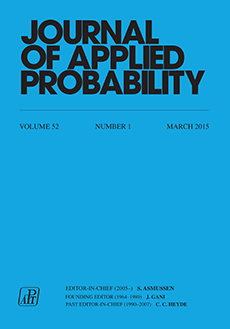Abstract
A large number n of sensors (finite connected intervals) are placed randomly on the real line so that the distances between the consecutive midpoints are independent random variables with expectation inversely proportional to n. In this work we address two fundamental sensor allocation problems. The interference problem tries to reallocate the sensors from their initial positions to eliminate overlaps. The coverage problem, on the other hand, allows overlaps, but tries to eliminate uncovered spaces between the originally placed sensors. Both problems seek to minimize the total sensor movement while reaching their respective goals. Using tools from queueing theory, Skorokhod reflections, and weak convergence, we investigate asymptotic behaviour of optimal costs as n increases to ∞. The introduced methodology is then used to address a more complicated, modified coverage problem, in which the overlaps between any two sensors can not exceed a certain parameter.
Citation
Evangelos Kranakis. Gennady Shaikhet. "Sensor allocation problems on the real line." J. Appl. Probab. 53 (3) 667 - 687, September 2016.
Information





